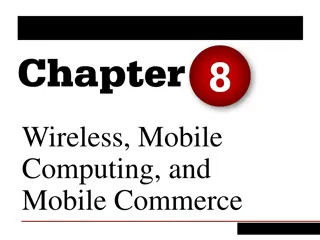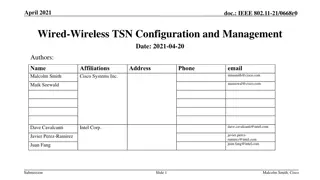Understanding Wireless Wide Area Networks (WWAN) and Cellular Network Principles
Wireless Wide Area Networks (WWAN) utilize cellular network technology like GSM to facilitate seamless communication for mobile users by creating cells in a geographic service area. Cellular networks are structured with backbone networks, base stations, and mobile stations, allowing for growth and continuity of communication through overlapping cells. The architecture of WWANs involves various levels of management and network components like Mobile Switching Centers and Radio Network Controllers, enabling efficient communication. Handoff procedures ensure uninterrupted calls as users move between cells.
Download Presentation

Please find below an Image/Link to download the presentation.
The content on the website is provided AS IS for your information and personal use only. It may not be sold, licensed, or shared on other websites without obtaining consent from the author. Download presentation by click this link. If you encounter any issues during the download, it is possible that the publisher has removed the file from their server.
E N D
Presentation Transcript
WWAN WWAN is a form of wireless network uses cellular network technology such as Global System for Mobile Communications (GSM). A cellular network uses a large number of low-power wireless transmitters to create cells - the basic geographic service area of a wireless communications system-. Mobile users travel from cell to cell, their conversations are handed of between cells to maintain seamless service. 2
Principles of cellular networks Cells can be added to accommodate growth, creating new cells in unserved areas or overlaying cells in existing areas. The cellular architecture consists of a backbone network with fixed base stations (BSs) interconnected through a fixed network (usually wired), and of mobile stations (MSs) that communicate with the base stations via wireless links. The geographic area within which mobile stations (MSs) can communicate with a particular base station (BS) is referred to a cell. 4
Principles of cellular networks Neighboring cells overlap with each other, thus ensuring continuity of communications when the users move from one cell to another. The MSs communicate with each other, and with other networks, through the base stations and the backbone network. A set of channels (frequencies) are allocated to each base station. 5
Architecture of WWANs Management Level AC OMC Operation & Maintenance Center VLR HLR ER Visitor Location Register Equipment Register Home Location Register Authentication Center Mobile Switching Center Network Level The Internet MSC RNC RNC Radio Network Controller Radio Level MS MS MS MS MS 6
Handoff The procedure of moving from one cell to another, while a call is in progress, is called handoff. While performing handoff, the MS requires that the BS in the cell where it has moved allocates a channel. If channel is not available in the new cell, the handoff call is blocked and blocking is called handoff blocking. 7
WWAN Technologies GSM (Global System for Mobile Communications) GPRS (General Packet Radio Service) EDGE (Enhanced Data Rate for GSM Evolution) UMTS (Universal Mobile Telecommunications System) HSPA (High Speed Packet Access) LTE (Long Term Evolution) 5G Evolution of Mobile technology: 0G, 1G, 2G, 3G, 4G & 5G 9
GSM GSM (Global System for Mobile Communications) Its started since 1991, (2 G). It uses digital systems It uses TDMA as access method GSM operates in 900 MHz band (890 MHz - 960 MHz) GSM Data rate is 9.6 ~ 14.4 Kbps. 10
GPRS GPRS (General Packet Radio Service) GPRS is an alternative to circuit-switched voice connection (2.5 G, since 2000+) GPRS uses Internet Protocol Its used in smartphones GPRS Data rate is 114 Kbps. Transmit and receive E-mails 11
EDGE EDGE (Enhanced Data Rate for GSM Evolution) EDGE is a digital technology based on GSM technology (2.75 G), since 2003. Mobile Phones should support EDGE technology EDGE technology available in more than 170 countries all over the world. EDGE Data rate is 474 Kbps. 12
UMTS UMTS (Universal Mobile Telecommunications System) UMTS is a voice and high-speed data technology (3G) based on GSM technology. WCDMA (Wideband-CDMA) & UMTS are used interchangeably. UMTS based on Internet Protocol (IP) . UMTS Data rate is 384 Kbps (original release). 13
HSPA HSPA (High Speed Packet Access) HSPA is a terminology used when both HSDPA (High Speed Downlink Packet Access and HSUPA (High Speed Uplink Packet Access) are deployed in a network. Speed 14 Mbps on downlink & 5.8 Mbps on uplink in a 5Mhz channel. HSPA+: (Evolved HSPA) speed is 21 Mbps 14
LTE LTE Long Term Evolution It is 4G Technology, since 2009. It is based on GSM/EDGE and UMTS/HSPA Technologies. Its main objective is to increase the capacity and speed of wireless data networks. LTE Average Speed is 50 Mbps LTE operates in 2100 MHz band 15
5G 5G stands for the fifth generation of mobile networks The 5G New Radio (NR) technology is based on OFDMA Average download speeds of around 400 Mbps The higher frequency bands for 5G have limited coverage but very low latency 5G networks operate on rarely used radio millimeter bands in the 30 GHz to 300 GHz range 16
WWAN Security UICC (Universal Integrated Circuit Card) is a new generation of SIM, it stores pre-shared key, and Performs cryptographic operations for authentication. Authentication and Key Agreement (AKA) is the protocol used for devices to authenticate with the carrier to gain network access. The cryptographic keys needed to encrypt calls are generated upon completion of the AKA protocol 17























